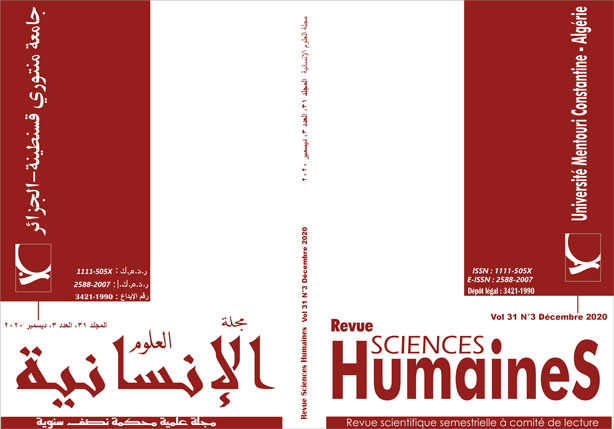تقريب الثقافة باستخدام الفكاهة في قسم تدريس اللغة الإنجليزية كلغة أجنبية
في قسم الأداب و اللغة الإنجليزية, جامعة الإخوة منتوري قسنطينة 1
الكلمات المفتاحية:
تعليم اللغة، ثقافة، فكاهة، الجامعةالملخص
يتمحور تدريس اللغة حول مفهوم قواعدي يلغي حجم الثقافة والتي تشكل خلفية كبيرة لما يقال وهذا ما يتطلب اِعادة النظر في طريقة التعليم بحيث تتناسب مع الثقافة وحجمها. تعتبر الجدية المبالغ فيها في الاقسام السبب الاساسي للتوتر والقلق عند الطلبة و لذلك وجب توفير الجو المناسب الذي من شأنه ان يشجع على الدراسة و يقضي على الملل، ولهذه الغاية تشكل الفكاهة انجع طريقة للتخلص من الملل والتحفيز على تعلم الثقافة. لذلك تهدف هذه الدراسة الى تحليل رغبة الطلبة في تعلم الثقافة من خلال الفكاهة، وتعتمد على دراسة وصفية قائمة على استبيان كأداة للبحث عن فعالية الفكاهة في القسم. تم تقديم هذا الاستبيان الى عينة متكونة من 46 طالبا انتقيت من 250 طالبا في السنة الثانية للعام الجامعي 2016- 2017 من قسم الآداب واللغة الانجليزية في جامعة الاخوة منتوري قسنطينة1. وخلصت الدراسة الى ان تضمين الفكاهة في اقسام تعليم اللغات الاجنبية مطلوب لكونها توفر البيئة المناسبة للدراسة كما تساعد على تعلم الثقافة الاجنبية.
التنزيلات
المراجع
Aboudan, R. (2009). Laugh and Learn: Humour and Learning a second Language. International Journal of Arts and Sciences, 3 (3),90-99. http:// www. Researchgate. net
Abraham, R., Hande, V., Sharma, M., Wohlrath, S., Keet, C.,& Ravi, S.(2014). Use of Humour in Classroom Teaching: Students' Perspectives. Thrita Journal, 3 (2). doi: 10.5812/ thrita.10517. thritajournal. portal.tools
Alred, G., Byram, M., &Fleming, M.(Eds.).(2003). Intercultural Experience and Education. Britain, UK: Multilingual Ltd Matters.
Boone, H., & Boone, D. (2012). Analysing Likert Data. Journal of Extension. 50 (2). www. joe. org
Byram, M. (1989). Cultural Studies in Foreign Language Education. Clevedon, Avon: Multilingual Matters.
Byram, M. (1997). Teaching and Assessing Intercultural Communicative Competence. Clevedon: Multilingual Matters Ltd.
Byram, M., & Fleming, M., (1998). Language Learning in Intercultural Perspective: Approaches through Drama and Ethnography. UK: Cambridge University Press.
Coolican, H., Research Methods and Statistics in Psychology. Hodder &Stoughton, Hodder Headline Group.
Corbett, J., (2003). An intercultural Approach to English Language Teaching. Clevedon, Multilingual Matters Ltd.
Hanoune, S., (2012). Humour in English Foreign Language Teaching. EL-Tawassol: Langues, Culture et Littérature. 31: 79-88. dpubma. univ-annaba.dz
Harrison, B.,(Ed). (1990). Culture and the Language Classroom. The British Council: Modern English Publication.
Hinkel, E., (1999). Culture in Second Language Teaching and Learning. New York, NY: Cambridge University Press.
Hofstede, G.J., Pedersen, P., Hofstede, G. (2002). Exploring Culture. London, UK: Intercultural Press.
Kramsch, C., (1993). Content and Culture in Language Teaching. New York, NY: Oxford University Press.
Ladousse, G.P. (1987). Role Play. New York, NY: Oxford University Press.
Martin, R., (2007). The Psychology of Humour: an Interactive Approach. Burlington, MA: Academic Press.
Medgyes, P. (2002). Laughing Matters: Humour in the Language Classroom. New York, NY: Cambridge University Press.
Merriam, D. (2014). Merriam Webster Dictionary online. Retrieved from http: //www. merriam-webster. com/dictionary/humour
Miller, S. (1984). Experimental Design and Statistics. London: Routledge.
Pallant, J. (2005). SPSS Survival Manual: a Step by Step Guide to Data Analysis Using SPSS. Australia: Allen & Unwin.
Plester, B. (2016). The Complexity of Workplace Humour: Laughter, Jokes and the Dark Side of Humour. London: Springer International Publishing.
Raskin, V. (1985). Semantic Mechanisms of Humour. Dordrecht, Holland: D. Reidel Publishing Company.
Richards, J. & Rodgers, Th. (1986). Approaches and Methods in Language Teaching: A Desciption and Analysis. Cambridge: Cambridge University Press.
Shade, A. (1996).License to laugh: Humour in the Classroom. USA: Teacher Ideas Press.
Singh, Y. (2006). Fundamental of Research Methodology and Statistics. New Delhi, India: New Age International Publishers.
Sinscalco, M., & Auriat, N. (2005). Quantitative Research Methods in Educational Planning. UNESCO International Institute for Educational Planning. http://www. Unesco.org/iiep
Simpson, P. (2003). On the Discourse of Satire. Amsterdam, Netherlands: John Benjamins B.V.
Stryker, S.B., & Leaver, B.L. (Eds). (1997). Content-based Instruction in Foreign Language Education: Models and Methods. Washington: Georgetown University Press.
Tomlin, B., & Stempleski, S.(1993). Cultural Awareness. New York, NY: Oxford University Press.
Wagner, P. (2007). Let's Laugh: Discovering How Laughter Will Make You Healthy. USA: Destiny Image Publishers, In
التنزيلات
منشور
إصدار
القسم
الرخصة

هذا العمل مرخص بموجب Creative Commons Attribution-NonCommercial-ShareAlike 4.0 International License.












